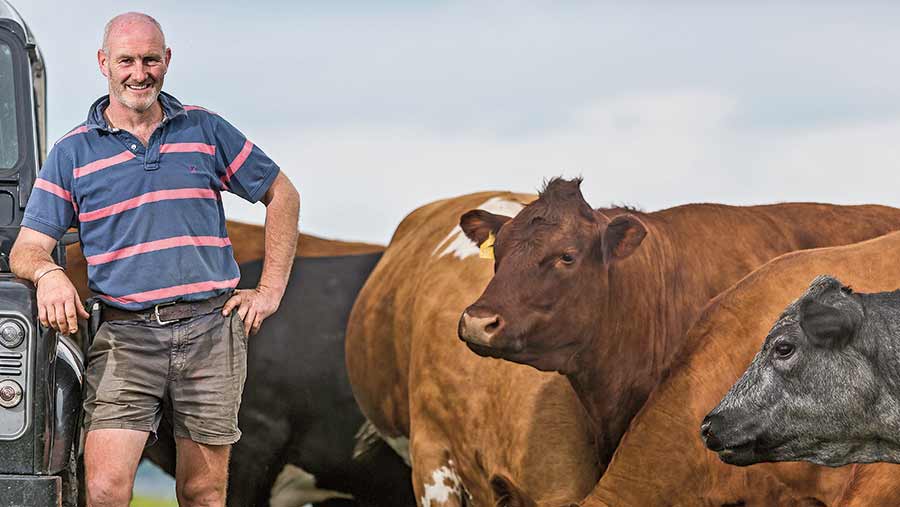Farmers Weekly Awards 2016: Beef Farmer of the Year
Richard Tudor
Llysun Farm, Llanerfyl, Powys
Richard Tudor is a shining example of how upland beef enterprises can thrive, even in the toughest of climates.
He wowed the judges with his impressive business performance on the day of the visit.

Richard Tudor © Richard Stanton
What sets him apart is his attention to detail, which is driving the phenomenal technical performance of his beef enterprise.
See also: 2016 Farmers Weekly Awards: Beef Farmer of the Year finalists revealed
He is making the most of every morsel of land for his spring-calving, 140-cow suckler herd to generate outstanding gross margins of £704 a cow – £100 above the best Welsh upland farms on average.
Farm facts
- 290ha upland farm plus 20ha rented
- 140 spring-calving cows plus 1,200 ewes and 300 lambs
- High health status – bovine viral diarrhoea-accredited and infectious bovine rhinotracheitis negative
- Texel-cross lambs finished off on grass and sold to Waitrose
- 98% of calves born alive a cow scanned
Richard is putting into practice learnings from various industry travel scholarships and is now placing a strong focus on herd fertility.
He is also as perfecting his breeding programme to develop a medium-sized cow that will thrive in upland conditions.
Saler heifers are put to an Angus bull to breed replacements.
Half of the main herd is crossed to a high-index, terminal-sire Charolais bull within the top 5% of the breed for 200-day weights, while bigger, Simmental-type cows are mated with a Saler.
Through his strong focus on fertility, rigorous breeding checks and use of AI, Richard is achieving unbelievable conception rates, with 75% of the herd calving in the first three weeks of the calving period and 90% in six weeks.
This approach to maximising herd fertility, combined with Richard’s focus on high 200-day weight estimated breeding values (EBVs), is contributing to phenomenal calf performance, with April-born steers and heifers averaging daily liveweight gains of 1.53kg up to weaning.
Winning ways
- Impressive business performance
- Outstanding grassland management
- Exceptional calf growth rates
- Strong focus on herd fertility
This figure is even more impressive when you consider calves are fed a forage-based diet alone up to weaning in October, when they are housed in cubicles and calves have access to creep and good-quality silage.
Richard is turning forage into rocket fuel by using all the tools accessible to him to ramp up his grassland productivity.
To make the best use of his poorer-quality hill ground, where land rises to 425m, annual soil sampling is carried out and he rotational grazes mixed stock.
“On the hill ground, the aim is to keep the pH, K and P right and the cattle manage the grass,” he says.
He is also trailblazing new grass varieties as part of his role as a Farming Connect demonstration farm, and this year he became the first farm in the UK to grow Fixation – a high-protein and deep-rooting clover variety that comes from Oregon in the US.
About 20ha is reseeded annually and on lower-lying ground Richard is using a mix of herbal grass leys, plantain for grazing and high-sugar grass and white clover to make high-energy forage.
He is sharing his expertise with the wider industry. As well as sitting on the NFU Welsh livestock board and the Hybu Cig Cymru research and development committee, he employs two college apprentices part-time and hopes to create a viable farming future for the younger generation in Wales.
Sponsor’s view
 “The sustainability of the beef industry is crucial to a business such as ours, and Richard shows how attention to detail in management and a focus on the end customer can deliver that sustainability.”
“The sustainability of the beef industry is crucial to a business such as ours, and Richard shows how attention to detail in management and a focus on the end customer can deliver that sustainability.”
Connor McVeigh, McDonald’s supply chain director
